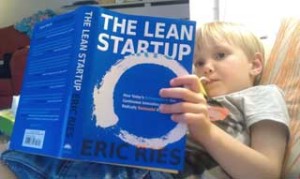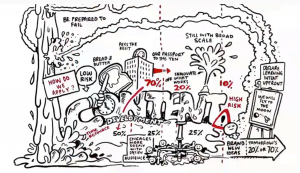 I believe that one of the under-appreciated aspects of Agile Marketing, particularly for those teams that practice Scrum, is the value of cadence. Let me explain.
I believe that one of the under-appreciated aspects of Agile Marketing, particularly for those teams that practice Scrum, is the value of cadence. Let me explain.
Daily
Every day, Agile Marketers practicing Scrum have an opportunity to review their progress, set daily goals, and make their peers and the scrum master aware of any obstacles that are blocking them from getting their work done. This communication to peers keeps everyone on the team informed as to how the work is progressing and what obstacles might be in the way. It is the duty of the Scrum Master to find ways to eliminate these obstacles, so that work can get back on track quickly. Also, through visual tools like the Kanban board and the Burndown chart, teams can see how the work is progressing, and whether they are on track to complete the committed work by the end of the Sprint.
This valuable team communication takes place in just 15 minutes a day. Because problems are identified at the Daily Scrum, not solved or hashed over, the scrum meeting is kept short and focused. Problems are solved offline, with the involvement of the Scrum Master and those people who can remove the obstacle, eliminating time wasted by sitting through irrelevant portions of meetings.
One of the advantages of the prescribed meetings of Scrum is that they eliminate or greatly reduce the need for additional meetings, freeing teams up to get more work done.
Another daily activity for Agile Marketing teams is brand monitoring and News Jacking opportunity assessment. In our Agile practice, we recommend that teams assign someone to monitor any and all mentions of the brand, key executives, product names, product categories and competitors. We also recommend that companies establish in advance a team whose is responsible for reacting quickly to brand damaging events. In addition to naming the members of the team, the company should identify in advance the call up and deployment process for the brand damage team. Lastly, companies should empower this team to make decisions quickly and at a local level. Most companies would find it irresponsible not to have a disaster recovery plan for their physical plant and assets. But few of them have the same kind of disaster recovery plan for damage to their brand.
Assessing opportunities for gaining positive PR through News Jacking should also be a daily activity. If you’re not familiar with News Jacking, I’d suggest reading David Meerman Scott’s short book on the topic, or taking his class. This is an under-utilized technique for garnering positive PR.
Every 1-4 Weeks (i.e., every Sprint)
The end of one Sprint and the beginning of the next Sprint present a number of opportunities for the Agile team, and these meetings are a regular part of the Agile cadence. Let’s start with the Sprint Review.
Done properly, the Sprint Review, or “The Demo” as it is sometimes known, communicates to management and to sales the progress of marketing. During the Sprint Review, invitees from executive management and sales are shown the latest marketing materials created for their use, and asked for their feedback. They are also invited to review the previously established priorities and given the opportunity to adjust these priorities as necessary. The marketing team shares data and learning from the latest experiments, including what worked and what didn’t work, and solicits further feedback.
This transparency stands in remarkable contrast to the traditional “post-mortem” of big bang campaigns, where because of the money spent and the time involved, marketing teams almost never admit that the big bang campaign failed or wasn’t as successful as expected. Because many agile marketing experiments are small and cheap, and because a certain amount of failure is to be expected in order to ensure that the team is learning and taking chances, there is no incentive to spin the results or hide anything from management.
The Sprint Retrospective provides a great opportunity for the team to learn and improve on a consistent basis. In this case, the meeting does not include sales or executive management, but only members of the team. The retrospective should be a candid conversation about what’s working and what’s not. What should we stop doing because it’s not providing value? What should we start doing that we’re not? And what new processes have we introduced, with some success, that we should double-down on? Over time, these regular opportunities for self-assessment can lead to a very smoothly functioning team, one that has adapted the various practices of methodologies such as Kanban, Scrum and Lean to create a working style that is unique to that particular team.
Lastly, the end of each Sprint also means the beginning of a new Sprint, and the Sprint Planning meeting provides the team with the opportunity to re-assess priorities and make commitments to new work.
When teams are in the thick of big yearly or half-yearly campaigns, they can often lose sight of strategic imperatives and there is less time to re-adjust priorities according to changing market conditions. The cadence of Agile forces re-assessment on a regular basis, at least on the kinds of user stories and tasks that get added to the marketing backlog.
I often get asked questions along the following lines: “How do Agile teams stay strategic? It seem’s clear that Agile can help teams stay heads down and get tasks done in an efficient manner, but how do they keep up with major shifts in the market? Particularly if the team is conducting experiments and making decisions based on A/B testing and other quantitative, focused methodologies, how do they avoid getting blind-sided by trends where there is no simple A/B test? What about data that comes in from other sources, perhaps discussions with partners or customers, or observations of new, disruptive technologies and the impact they might have on the companies business model? Is there a mechanism for Agile teams to stay strategic at a high level?”
Quarterly
Quarterly strategic planning sessions, generally either a half or a full-day in length, provide Agile leaders with the opportunity to examine out-dated strategic assumptions and keep up to date with new technologies and trends.
I believe there are three keys to success with this kind of quarterly strategic planning. First, much like preparing to handle brand damaging events, at least one person and sometimes a small team need to have it as part of their job to monitor the environment (customers, partners, competitors, etc) for threats and opportunities, and to bring these observations to the quarterly meetings.
Second, the group needs a sound methodology for strategic planning and needs to incorporate this methodology into the content and process of the quarterly meetings. Two methodologies that come to mind are the “Jobs to be Done” methodology popularized by Clayton Christiansen and the Business Model Generation methodology, championed by Alexander Osterwalder. Whichever methodology is chosen, the moderator should make sure that the discussion stays focused and that follow up actions are assigned and given deadlines.
Third, the results of this strategic planning needs to be summarized in a one or two page document, and shared widely. This document should articulate a small set of initiatives, in particular initiatives that have the potential to generate new user stories and tasks for the marketing backlog. These initiatives also inform the prioritization of user stories and tasks during future Sprint planning sessions.
Summary
As I hope I’ve illustrated, Agile Marketing has a cadence, with various activities taking place on a daily, weekly and quarterly basis. The discipline of this cadence helps teams get work done, identify and solve problems quickly, and maintain a balance between tactical execution and strategic planning.





Jim it should be noted that the cadence is variable and that the frequency is not set in stone. For some organizations the daily Scrum (stand up) is not always practical especially in larger marketing groups or distributed teams. I would suggest that the Scrum cadence above is a good starting point but organizations tailor the cadence frequency to suit the organization and situation. In my own experience we currently run a weekly Scrum meeting after trying a daily approach. The cadence in Scrum is a fundamental part of the approach and part of its strength and something that should be implemented.
Rupert, couldn’t agree more. Many marketing organizations don’t run daily Scrum meetings, but move to once or twice a week, as you’ve found. Thanks for commenting.